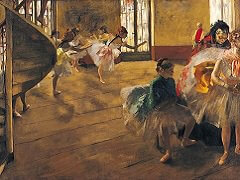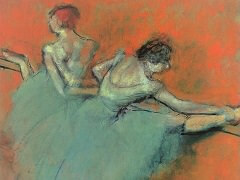Breakfast after the Bath by Edgar Degas

This painting, Breakfast after the Bath, is one of the few paintings complete statements of a theme which was to occupy Degas for the rest of his life. More and more he began to study the female nude, not in the way the old masters had, discreetly in some historical or mythological setting, but frankly for itself. This was the new realism in painting, divorced from the idyllic settings of a Corot or the heavy forest backgrounds of Courbet. All of Degas' respect for classical tradition found its expression in pictures of this sort. He added a note that was new, that of observing, strongly and passionately, woman in her bedroom, in her bath, engaged in all the simple, expressive tasks of combing her hair, toweling herself, twisting, bending, and turning in those energetic actions which bring out the structure of the body and its play of muscle and flesh.
Here the artist chose to develop a moment, stressing the energetic movement of the nude woman with her moving, agitated arabesque of form, pitting it against the calm, column-like figure of the servant, connecting the two with the curves of the tub. The naked body is strongly modeled in color, and Degas shows how much he depended on the Impressionist method of turning light into brilliant hues, building through green shadows and violet and pink highlights a solid form, which in turn catches and reflects the glowing colors of the room, and weaves throughout a harmony rich and unusual in its combinations. In certain areas patterns of one color are laid over another; the technique is one of pastel built up in solid masses, streaked and retouched again and again for dramatic emphasis of color and drawing.
















